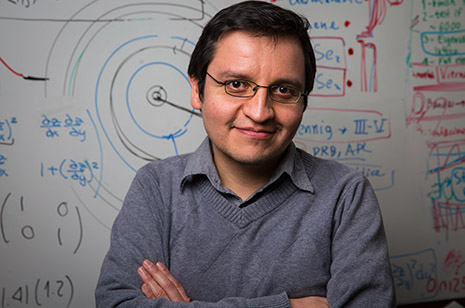Researchers Develop New Mathematical Framework to Characterize Shape of Graphene
FAYETTEVILLE, Ark. — Scientists studying graphene’s properties are using a new mathematical framework to make extremely accurate characterizations of the two-dimensional material’s shape.
Graphene, discovered in 2004, is a one-atom-thick sheet of graphite.
“The properties of two-dimensional materials depend on shape,” said Salvador Barraza-Lopez, an assistant professor of physics at the University of Arkansas. “And this mathematical framework allows you to make extremely accurate characterizations of shape. This framework is a novel tool to understand shape in materials that behave as atom-thin membranes.”
The mathematical framework being used is known as discrete differential geometry, which is the geometry of two-dimensional interlaced structures called meshes. When the nodes of the structure, or mesh points, correspond with atomic positions, discrete differential geometry provides direct information on the potential chemistry and on the electronic properties of two-dimensional materials, Barraza-Lopez said.
The application of discrete differential geometry to understand two-dimensional materials is an original interdisciplinary development, he said.
An international research group, led by Barraza-Lopez, published its findings on Jan. 8 in the journal ACS Nano, in a paper titled, “Quantitative Chemistry and the Discrete Geometry of Conformal Atom-Thin Crystals.” A second article describing the research, “Graphene’s morphology and electronic properties from discrete differential geometry,” was published March 6 as a rapid communication in the journal Physical Review B.
Graphene was once thought of as existing on a continuum — think of a smooth, continuous “blanket” — but the new mathematical framework allows the consideration of the blanket’s “fibers,” which provides an accurate understanding of the blanket’s properties that complements the continuum perspective.
“Since two-dimensional materials can be easily visualized as meshes, we asked ourselves how these theories would look if you express them directly in terms of the positions of the atoms, bypassing entirely the common continuum approximation,” Barraza-Lopez said. “These two papers provide our latest strides towards that direction.”
The results for the study published in ACS Nano on Jan 8 were obtained through a collaborative effort with Alejandro A. Pacheco Sanjuan at Universidad del Norte, Barranquilla, Colombia; Edmund O. Harriss, a clinical assistant professor of mathematics at the University of Arkansas; Mehrshad Mehboudi, a master’s student in microelectronics-photonics at the University of Arkansas and Humberto Terrones, then at Pennsylvania State University, now at Rensselaer Polytechnic Institute.
Collaborators on the rapid communication published in Physical Review B on March 6 were Pacheco Sanjuan; Hamed Pour Imani, a physics doctoral student at the University of Arkansas; Zhengfei Wang at the University of Utah; and Mihajlo Vanevic at the University of Belgrade, Serbia.
Topics
Contacts
Salvador Barraza-Lopez, assistant professor, physics
J. William Fulbright College of Arts and Sciences
479-575-5933,
sbarraza@uark.edu
Chris Branam, research communications writer/editor
University Relations
479-575-4737,
cwbranam@uark.edu
Headlines
U of A's Inspirational Chorale Makes Its Carnegie Hall Debut
The U of A's Inspirational Chorale took center stage at Carnegie Hall in March, performing under the direction of professor Jeffrey Murdock to a packed audience at the iconic Stern Auditorium.
The State of Economics With Mervin Jebaraj Set for June 5
U of A economist Mervin Jebaraj will analyze state's economic trends and regional issues in an upcoming talk. Preregistration is required by May 31.
Faculty Demonstrate Dedication to Student Success Through Teaching Credentials
Eight faculty members from across the U of A have earned the prestigious Association of College and University Educators certification in Effective College Teaching.
Artificial Intelligence, Machine Learning Boost Arkansas Animal Science Research
Aranyak Goswami, a bioinformatics specialist, will work with three different departments to boost the research arm of the U of A System Division of Agriculture.
College of Education and Health Professions Doctoral Student Picked for Grosvenor Fellowship
Jessica Culver, a doctoral student in the College of Education and Health Professions Adult and Lifelong Learning program, has been selected as a member of the 2024 Grosvenor Teacher Fellowship.





